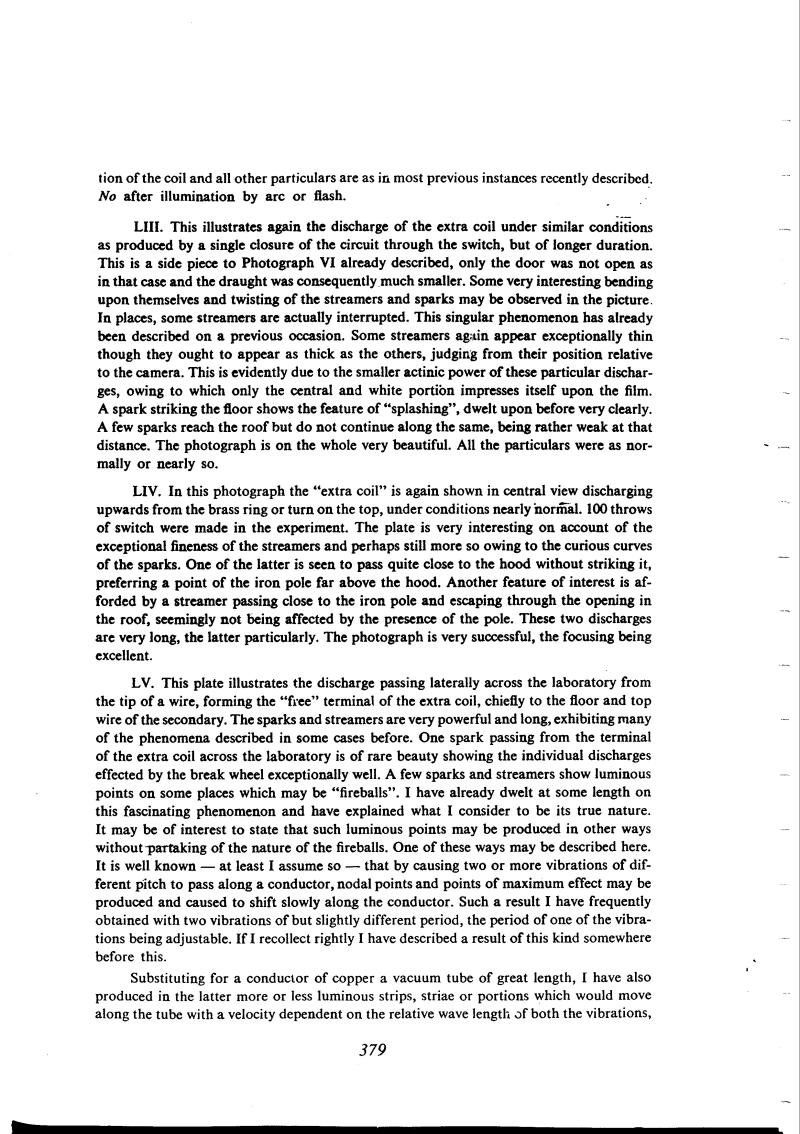tion of the coil and all other particulars are as in most previous instances recently described. No after illumination by arc or flash.
LIII. This illustrates again the discharge of the extra coil under similar conditions as produced by a single closure of the circuit through the switch, but of longer duration. This is a side piece to Photograph VI already described, only the door was not open as in that case and the draught was consequently much smaller. Some very interesting bending upon themselves and twisting of the streamers and sparks may be observed in the picture. In places, some streamers are actually interrupted. This singular phenomenon has already been described on a previous occasion. Some streamers again appear exceptionally thin though they ought to appear as thick as the others, judging from their position relative to the camera. This is evidently due to the smaller actinic power of these particular discharges, owing to which only the central and white portion impresses itself upon the film. A spark striking the floor shows the feature of “splashing”, dwelt upon before very clearly. A few sparks reach the roof but do not continue along the same, being rather weak at that distance. The photograph is on the whole very beautiful. All the particulars were as normally or nearly so.
LIV. In this photograph the “extra coil” is again shown in central view discharging upwards from the brass ring or turn on the top, under conditions nearly normal. 100 throws of switch were made in the experiment. The plate is very interesting on account of the exceptional fineness of the streamers and perhaps still more so owing to the curious curves of the sparks. One of the latter is seen to pass quite close to the hood without striking it, preferring a point of the iron pole far above the hood. Another feature of interest is afforded by a streamer passing close to the iron pole and escaping through the opening in the roof, seemingly not being affected by the presence of the pole. These two discharges are very long, the latter particularly. The photograph is very successful, the focusing being excellent.
LV. This plate illustrates the discharge passing laterally across the laboratory from the tip of a wire, forming the “free” terminal of the extra coil, chiefly to the floor and top wire of the secondary. The sparks and streamers are very powerful and long, exhibiting many of the phenomena described in some cases before. One spark passing from the terminal of the extra coil across the laboratory is of rare beauty showing the individual discharges effected by the break wheel exceptionally well. A few sparks and streamers show luminous points on some places which may be “fireballs”. I have already dwelt at some length on this fascinating phenomenon and have explained what I consider to be its true nature. It may be of interest to state that such luminous points may be produced in other ways without partaking of the nature of the fireballs. One of these ways may be described here. It is well known - at least I assume so - that by causing two or more vibrations of different pitch to pass along a conductor, nodal points and points of maximum effect may be produced and caused to shift slowly along the conductor. Such a result I have frequently obtained with two vibrations of but slightly different period, the period of one of the vibrations being adjustable. If I recollect rightly I have described a result of this kind somewhere before this.
Substituting for a conductor of copper a vacuum tube of great length, I have also produced in the latter more or less luminous strips, striae or portions which would move along the tube with a velocity dependent on the relative wave length of both the vibrations,
379


